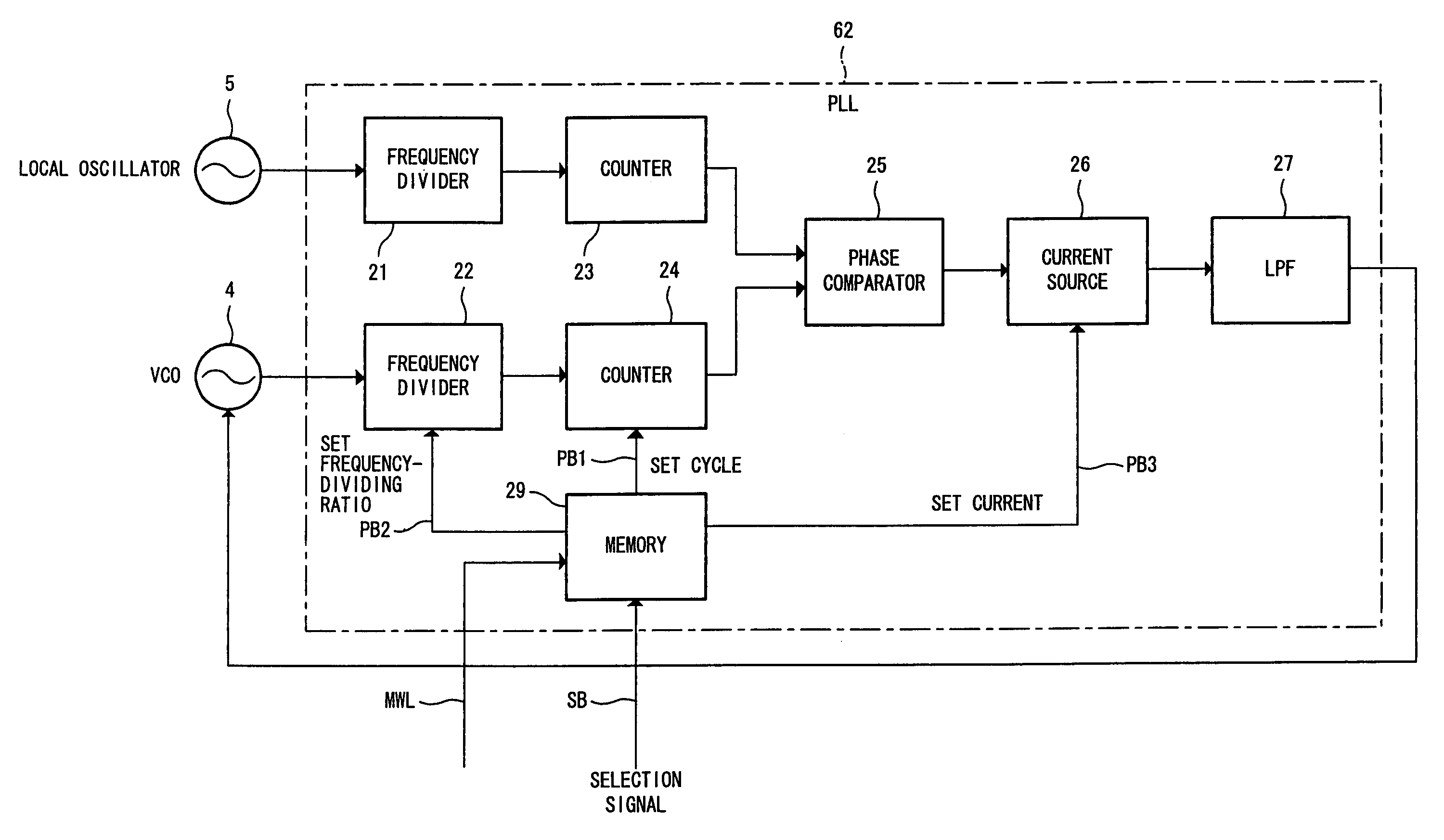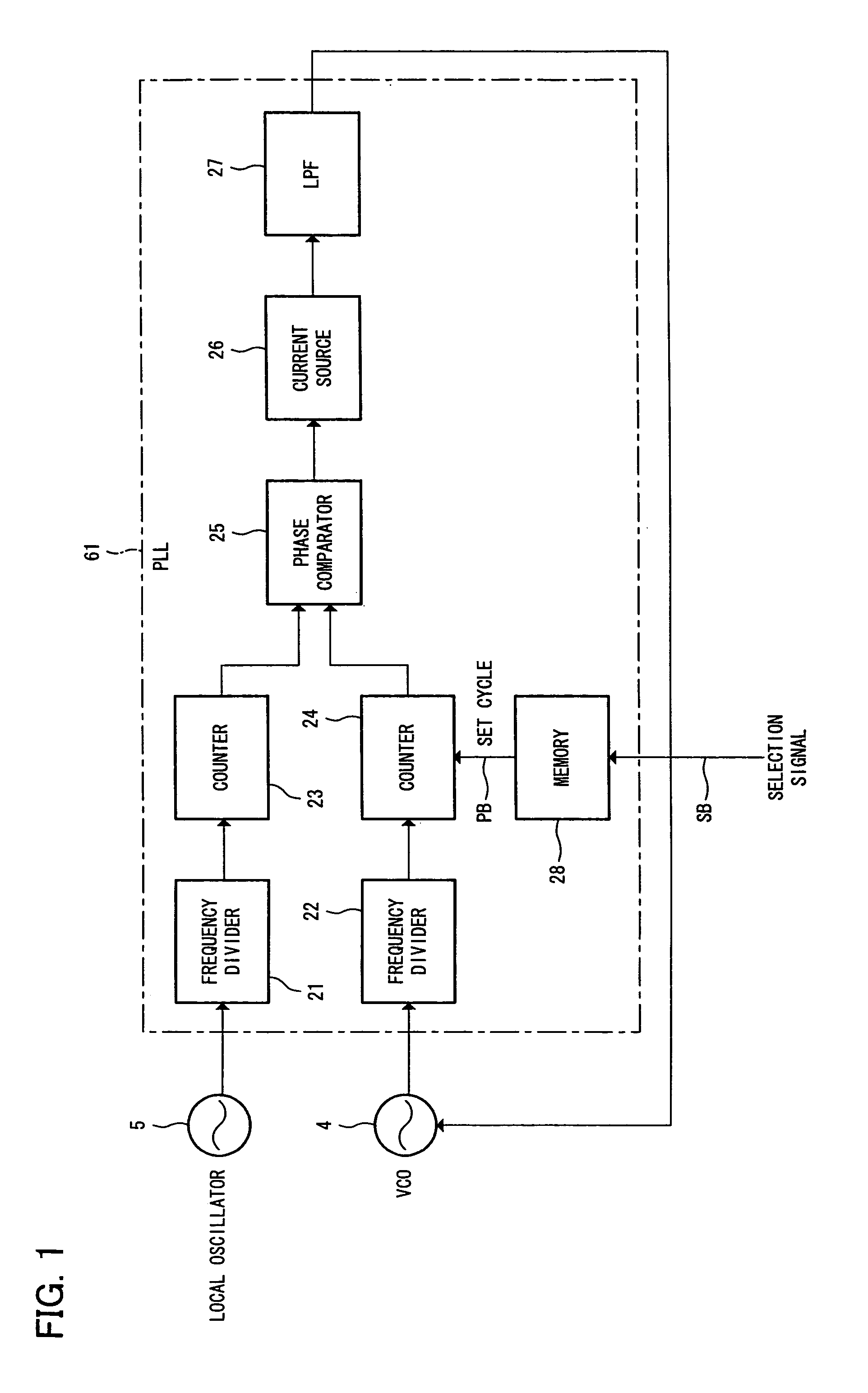PLL circuit and high-frequency receiving device
a high-frequency receiving and circuit technology, applied in the direction of digital transmission, generating/distributing signals, baseband system details, etc., can solve the problem of taking time to set a cycle, and achieve the effect of shortening the tim
- Summary
- Abstract
- Description
- Claims
- Application Information
AI Technical Summary
Benefits of technology
Problems solved by technology
Method used
Image
Examples
first embodiment
[0036]FIG. 1 is a block diagram illustrating an arrangement of a PLL circuit 61 according to the present embodiment.
[0037]As illustrated in FIG. 1, the PLL circuit 61 has frequency dividers 21 and 22, counters 23 and 24, a phase comparator 25, a current source 26, a low-pass filter (LPF) 27, and a memory 28.
[0038]The frequency divider 21 divides at a predetermined frequency-dividing ratio a frequency signal, outputted from a local oscillator 5, which serves as a reference of a local signal outputted by a voltage-control local oscillator (VCO) 4. The frequency divider 22 divides at a predetermined frequency-dividing ratio an output signal from the voltage-control local oscillator (VCO) 4. In order to make it easy for the counters 23 and 24 to count, the frequency divider 22 functions as a prescaler which divides in advance an output of the high-frequency local oscillator 5 and an output of the VCO 4.
[0039]The counter 23 counts down (or counts up) the frequency-divided signal divided ...
second embodiment
[0050]FIG. 3 is a block diagram illustrating an arrangement of a PLL circuit 62 according to the present embodiment.
[0051]As illustrated in FIG. 3, the PLL circuit 62, as with the PLL circuit 61 described above, has frequency dividers 21 and 22, counters 23 and 24, a phase comparator 25, a current source 26, a low-pass filter (LPF) 27. However, the PLL circuit 62 has a memory 29 instead of a memory 28.
[0052]Further, unlike the frequency divider 22 of the PLL circuit 61, the frequency divider 22 sets a frequency-dividing ratio and divides an output frequency of a VCO 4 at thus set frequency-dividing ratio. In case of changing a frequency accuracy in the PLL circuit 62, the frequency-dividing ratio setting of the frequency divider 22 is changed.
[0053]Moreover, unlike the current source 26 of the PLL circuit 61, the current source 26 selects and sets a plurality of current values (e.g., 2 mA and 4 mA) and outputs a current of a set current value. By changing a current value of the curr...
third embodiment
[0066]FIG. 5 is a block diagram illustrating an arrangement of a PLL circuit 63 according to the present embodiment.
[0067]As illustrated in FIG. 5, the PLL circuit 63, as with the PLL circuit 61, has frequency dividers 21 and 22, counters 23 and 24, a phase comparator 25, a current source 26, a low-pass filter (LPF) 27, a memory 29, and a selection circuit 30.
[0068]The selection circuit 30 selects, based on a selection signal supplied through a serial bus SB, either a setting pattern A inputted from outside through an external setting line ESL or a setting pattern B read out from the memory 29. The selection circuit 30 makes it possible to select a convenient set cycle depending on a situation. Such a situation is for example a situation where an external setting line ESL is used to operate the PLL circuit 63 at a value not stored in the memory 29 in the short run for testing and adjustment, and the memory 29 is used at normal times.
[0069]Further, the selection signal is transmitted...
PUM
 Login to View More
Login to View More Abstract
Description
Claims
Application Information
 Login to View More
Login to View More - R&D
- Intellectual Property
- Life Sciences
- Materials
- Tech Scout
- Unparalleled Data Quality
- Higher Quality Content
- 60% Fewer Hallucinations
Browse by: Latest US Patents, China's latest patents, Technical Efficacy Thesaurus, Application Domain, Technology Topic, Popular Technical Reports.
© 2025 PatSnap. All rights reserved.Legal|Privacy policy|Modern Slavery Act Transparency Statement|Sitemap|About US| Contact US: help@patsnap.com



